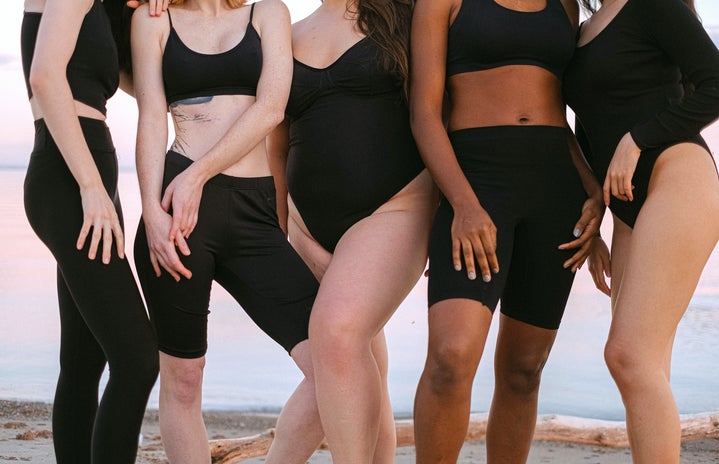The era of mini skirts and low-rise jeans is making a comeback. That means that thin is, once again, making its appearance in fashion. Or maybe it never left. No, I think it left, and now it’s back again. However this time, the “heroin chic” thin figure of the 90s is making its comeback as a rival to the progression of size inclusivity in the fashion industry in the past decade.
The term “heroin chic” was first coined in an article by the New York Post with the headline “Bye-bye booty, heroin chic is back.” With “heroin chic,” Post is describing the 90s look popularized by the grunge era Calvin Klein ads that starred stars such as Kate Moss and Jaime King. These ads worshiped thin bodies which is a recurring problem in the fashion industry. The term “heroin chic” also can come off as concerning due to the current opioid crisis. Post received a lot of backlash regarding their glorification of thin bodies. For example, “The Good Place” actress, Jameela Jamil wrote on her instagram: OUR BODIES ARE NOT TRENDS. SAY IT WITH ME.”
Or when Vogue writer Emma Specter tweeted, “Do people who insist the return of crop tops and low-rise jeans means we all have to adhere to early-aughts levels of compulsory thinness realize i will just………wear those things w my large and beautiful stomach hanging out?” Many think that thin bodies coming back ‘into style’ is the fashion industry’s way of lashing out towards the body positive movement, rendering it useless.
The start of this new era could be attributed to many celebrities reversing their cosmetic procedures. When you think of celebrities that pioneer the current beauty standard, you could think of the Kardashians. For example, many news outlets reported on the return of extreme thinness when Kim Kardashian lost 16 pounds in two weeks to fit into her outfit for the Met Gala. Additionally, many speculate that Kim had her BBL revised and reduced which then led to everyone talking about how “slim thick is out.”
So, shouldn’t women sigh in relief? Shouldn’t they be comforted they aren’t naturally built like Nicki Minaj? What about not having to undergo pricey and risky procedures such as getting a BBL? Maybe, but there are many women who are rightfully frustrated to see society’s back being turned on this era because it was more inclusive than the previous standard of thinness. Journalist Chloe Sih recently tweeted, “Curvy bodies becoming more celebrated takes away from that power. It reaffirms their internalized fatphobic belief that slim bodies are respectable and timeless.” While this tweet has some truth to it, we have to consider the opposite, that women who are flat chested and slim without being ‘slim thick’ were not desired. Additionally, BBL era only celebrated curves in the right place. Deposits of fat are welcomed in the butt, however, not the stomach. As a body standard, BBL era was not any more inclusive, since standards are made to be exclusionary.
In that sense, why does society even make body types, something women cannot change in an instant, trends? When body types are perceived as trends, just like clothes, there are no winners (well except plastic surgeons and dieticians I guess). Women risked their health wearing corsets in the 16th century, starving themselves during the first “heroin chic” era, and then getting on a surgeon’s table during the BBL era. I have no doubt that women will continue to risk their health to fit in with the next trend. For now, thinner women will be on a pedestal until the next body type trend comes, and obviously, these trends are based on women whose body types fall on and off of the “hot or not” list. What’s ironic is that women will eventually buckle and change themselves to look like how they are expected to and then will be shamed by men for not ‘loving their bodies.’
You must remind yourself that body types are not trends, because trends only pertain to things that are external to us, such as a type of clothing or accessory. We are born with our bodies and our bodies do so much for us that we should nurture and care for it. Focus on taking care of the body that you have rather than trying to squeeze it into others’ ideas of what looks good.
Hear that? 2002 called, it wants its unattainable beauty standards back.


